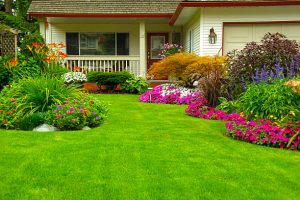Gardening is an ancient practice that has been enjoyed by humans for thousands of years. From the beautiful gardens of ancient civilizations to the picturesque landscapes of today, the art of gardening has evolved to become a form of self-expression and a way to connect with the natural world. In this essay, we will explore the importance of gardening, the various benefits it can have on our health and happiness, and the process of designing a garden that reflects the heart and soul of its creator.
The Importance of Gardening
Gardening is not just about creating a visually appealing outdoor space; it is about cultivating a connection between humans and the natural world. A well-designed landscape can provide a sanctuary for relaxation and reflection, while also enhancing the overall value and curb appeal of a property. Moreover, gardening can help to combat the negative effects of urbanization, such as air and water pollution, noise, and a lack of green spaces.
The various benefits of gardening on our health and happiness
Gardening has been shown to have numerous physical and mental health benefits. Some of these benefits include:
1. Improved mental health: Gardening can help to reduce stress, anxiety, and depression by promoting relaxation and providing a sense of accomplishment. The act of cultivating plants can also help to improve focus and concentration, making it a beneficial activity for individuals with attention deficit disorders.
2. Enhanced immune system: Studies have shown that gardening can boost the immune system, making it easier for our bodies to fight off infections and diseases. This is due to the presence of bacteria and other contaminants in the soil, which can help to train our immune systems to recognize and fight off foreign pathogens.
3. Increased physical activity: Gardening is a moderate-intensity physical activity that can help to improve cardiovascular fitness, strengthen muscles, and promote weight loss. By incorporating gardening into your daily routine, you can enjoy the benefits of exercise without it feeling like a chore.
4. Improved nutrition: Gardening can help to improve your diet by providing you with fresh, nutritious produce that is free from pesticides and other chemicals. You can also experiment with different varieties of plants, allowing you to enjoy a wider variety of vitamins and minerals.
5. Reduced stress levels: Gardening can help to lower cortisol levels, which are associated with stress. By spending time in your garden, you can enjoy a sense of peace and tranquility that can help to counteract the effects of modern life.
6. Improved cognitive function: Research has shown that gardening can help to improve cognitive function, including memory and attention. This is likely due to the combination of physical activity, fresh air, and the act of cultivating plants.
Designing a Garden that Reflects Your Heart and Soul
Designing a garden that reflects the heart and soul of its creator requires a deep connection to the natural world and a clear understanding of the various elements that make up a successful landscape. Here are some steps to help you create a garden that truly reflects your personal style and values:
1. Assess your space: The first step in designing your garden is to evaluate the space you have available. Consider the size, shape, and orientation of your yard, as well as any existing structures, such as your home, fence, or deck. This will help you determine the best layout and design for your garden.
2. Define your goals: Before you begin designing your garden, it is essential to understand your goals for the space. Are you looking to create a peaceful retreat, an outdoor dining area, or a children’s playground? Knowing your goals will help you prioritize the various elements of your design and ensure that your garden meets your needs and desires.
3. Analyze your climate and soil: Understanding your climate and soil type is crucial for selecting the appropriate plants and materials for your garden. Research the hardiness zone for your area and take note of the average precipitation, temperature, and sunlight hours. This information will help you choose plants that are well-suited to your environment and ensure the success of your garden.
4. Plan your layout: Now that you have a clear understanding of your space, goals, and climate, you can begin planning the layout of your garden. Consider the proportions of different elements, such as plants, paths, and seating areas, and make sure that the overall design is balanced and harmonious. Use sketches, photographs, and design software to help you visualize your garden and make adjustments as needed.
5. Choose your plants: Selecting the right plants for your garden is essential for creating a space that reflects your heart and soul. Consider your personal preferences, as well as the needs of your climate and soil. You may want to incorporate a mix of ornamental plants, flowers, shrubs, and trees to create a diverse and beautiful landscape.
6. Plan your irrigation and lighting: Proper irrigation and lighting are essential for the health and success of your garden. Consider installing an automated irrigation system to ensure that your plants receive the appropriate amount of water, and choose lighting fixtures that complement the overall atmosphere of your garden.
7. Add finishing touches: Once your garden is planted and irrigated, you can add the finishing touches that will make your outdoor space truly unique. This may include installing a water feature, such as a fountain or pond, building a pergola or arbor, or hanging a beautiful piece of artwork.
8. Maintain and enjoy your garden: Once your garden is complete, it is essential to maintain it properly to ensure its continued success. Regularly water, weed, and prune your plants, and take the time to enjoy the fruits (or vegetables) of your labor. Gardening is a lifelong journey, and with each passing season, your garden will evolve and grow, reflecting the changes in your own heart and soul.
Gardening is an ancient practice that offers numerous benefits for our health and happiness. By understanding the various styles and techniques used in different cultures and by following the steps outlined in this essay, you can design a garden that truly reflects your heart and soul. Your garden will not only be a beautiful and enjoyable outdoor space but also a testament to your love for the natural world and the importance of sustainability.
















Add Comment